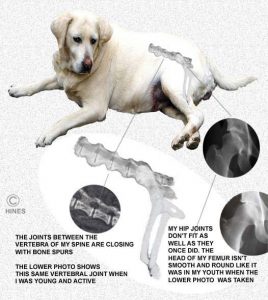

Dealing with Arthritis, Joint And Back Pain In Your Older Dog
Ron Hines DVM PhD
Arthritis is the most common health problem in older dogs. So if you own a dog, you will probably have to deal with it some day. Arthritis comes on in many ways, but the most common cause is the simple wear and tear your pet’s joints undergo over the years – They simply wear out. Veterinarians and physicians sometimes call arthritis, osteoarthritis or degenerative joint disease.
Nature’s solution to motion are biological hinges – two slick, smooth surfaces coating the bones that form each joint. The ends of the bones that form all movable joints are formed of a cushiony layer of cartilage that is coated by a slick, slippery membrane called the synovium. To reduce friction, the space in between is filled with an oily fluid, and the whole structure is bound together with a series of fibrous tissue and ligaments.
The secret to the long-term success of this wonderful apparatus is that its components are all living and capable of repair. But as we age, this repair process becomes less and less successful and makes errors. With years of repeated movement, several things begin to happen. The fibrous elastic sheets (fascia) and the ligaments begin to stretch, allowing the bones that form the joint to rattle slightly as they move. This in turn bruises and erodes the joints surfaces, causing inflammation. And as these surfaces continue to move, the inflammation causes new bone to be laid down where it does not belong, causing pain, and bone to be reabsorbed from where it is critically needed. This is called remodeling, and it is a vicious, painful cycle. Taken all together, this is what arthritis is.
The problems that lead to arthritis begin early in your pet’s life. But because joints are tough and reparative, you probably will not notice pain or lameness in your pet during its younger years.
When a particular joint is damaged through accident, or born misaligned, it may not be able to repair itself. That is the arthritis of car and other accidents. When the pet was born with abnormally shaped bones or abnormally lax joints (dysplasia), arthritis may appear in its youth. But neither of those causes are the subject of this article. If you would like to ready about the early onset of arthritis caused by hip dysplasia, go here.
Once arthritis is established in your pet, no mater what the cause, the treatment options available for your pet will be the same.
There are ways you can postpone or avoid arthritis when you make a decision to purchase a dog. Arthritis occurs sooner in certain breeds. Larger breeds and breeds that are called dysplastic, are likely to develop arthritis sooner in their lives. Arthritis also runs in family lines of dogs – generally bloodlines that are at the top end of their breed regarding size. If both parents of your dog did not develop arthritis until a ripe old age, your pet probably won’t either. Read about that here
If you do not get talked into early age neutering of your pet, it is likely to remain leaner and less susceptible to arthritis later in life. Read about that here.
If you allow your puppy to grow too rapidly, it will also be more prone to an earlier onset of arthritis. Read about that here.
What Is Actually Happening In My Pet’s Joints That Is Causing Him Pain?
Usually, veterinarians and pets benefit from studies conducted in animals that were designed to understand and treat health problems in people. However, when it comes to arthritis treatment, most veterinary knowledge has come from studies done in humans. That is because you can tell your doctor much better when his treatment relieves you from pain and debility, than your dog can tell your veterinarian. That, and a lack of Federal funding, is why so few significant, independent studies of arthritis have been done in dogs.
Luckily for our pets, there appears to be no difference in the processes that contribute or slow arthritis in pets and their owners. That is why most of the references I use in this article link to studies done in humans. But even those studies often have perplexing, contradictory, results. The US government invested 531.3 million dollars in arthritis research in one recent year.
What Are The First Signs Of Arthritis That I Will See In My Pet?
The telltale sign of arthritis in older dogs is a reluctance to move about. As your dog’s joints age, your pet will become more reluctant to run or play for long periods. It won’t bound up and down stairs like it used to and, on rising in the morning, it may be stiff and even limping. These changes almost always come on very gradually. It is easy to ignore or not notice them at first. Slowing down isn’t only related to your pet’s joints.
Large dogs, the ones that usually develop arthritis earlier, were bred to be very pain-resistant and Stoic. So, they won’t let you know that they are in pain until their arthritis problem is quite advanced.
As pets guard their sore joints, muscles and ligaments contract, decreasing the joint’s range of motion. You may notice that your pet no longer jumps up on sofas and chairs as it once did. One common symptom of age-related arthritis is that joints tend to be stiffer and more painful after periods of rest and that pain tends to work out during the day. By evening, your pet may be its old self again.
Arthritis problems tend to be worse in overweight pets. Some of their panting after a long walk can be due to arthritis pain and not just the overheating and out-of-shape problems that obesity produce. Cold days and dampness tend to make the problem worse as well.
What Tests Will My Vet Suggest To Confirm An Arthritis Problem?
Your veterinarian has learned to be a very good judge of the subtle signs that dogs give to tell us that they are in pain. It may be just a worried look in their eyes when the veterinarian overly flexes their joints. Or your pet may withdraw its leg, or even growl or snap. Your veterinarian will probably ask you to lead your pet around the examination room so he/she can observe its gait and locomotion. Over their career, vets get very good at that.
The veterinarian may notice that the major muscle masses of your pet’s legs and spine have shrunken (atrophied) due to disuse. Your pet may wince when areas of its spine are palpated.
But the key tests your veterinarian will perform are x-rays. Depending on how subtle the changes are, it may take more than a single x-ray film. X-rays of advanced arthritic joints are very distinctive. If you look at the hip and spinal photos of Hannah, at the top of this page, you can understand the changes your vet will see. Most veterinarians will set these x-rays up in the exam room and point out to you the important bone changes that they are seeing.
Are There Things I can Do To Slow Arthritis In My Pet?
Yes, and here are the important ones:
People can be better at describing treatments that relieve them of pain than pets are – so many of my links go to human studies.
Diet And Nutrition
What your pet eats and how much it eats throughout its life will affect arthritis in its later years. If your pet is overweight, reducing its weight, slowly, to a healthy level is one of the most important things you can do to reduce its discomfort. Read about that here.
Pets love to eat, that, and your company, are their chief pleasures in life. So if it has too much food in front of it, or if its food is not healthy, it will likely over eat.
Rather than rob your pet of its pleasure, feed it a lower caloric diet. Many are available commercially, and you can make wonderful ones at home. You will find more on home cooked diets here. If you don’t have the time or inclination to prepare them, at least add low caloric items like cooked cabbage, greens and carrots to your pet’s current diet to keep it satisfied while dieting.
All major pet food manufacturers offer “Senior” brands of food. Those diets tend to be lower in calories, higher in fiber and with added glucosamine, calcium, omega-3 fatty acids and antioxidants. No brands have been adequately tested to see if they actually help older dogs, but they are all nutritious and there is no downside to using them.
Exercise
Canine athletes, such as sled dogs and working greyhounds, just like human athletes, tend to develop arthritis earlier in life. But a moderate amount of daily exercise, like taking walks and interactive play-time, is thought to delay arthritis. There is no dog data or studies, but there are human studies that can be applied to dogs. Read about that here.
Good Nail And Foot Care
It is important that you keep your pet’s toenails clipped properly so its normal walking and running gait is not distorted. Over grown toenails are a lot like uncomfortable and poorly designed shoes that can also lead to arthritis in humans. They place abnormal stress on the joints and ligaments of the feet. There are rosin sprays that you can apply to your pet’s foot pads to help it walk more confidently. See one here. Never remove too much toenail at a time. Trim them off in multiple sessions over a period of weeks until they just touch the floor when your pet is standing.
Whirlpool, Heat Treatments And Hydrotherapy
Hot tubs, whirlpools and controlled swimming are great for pets with arthritis. Short periods of increased warmth, interspersed with cold, can decrease your pet’s aches and pains. Added heat from heating pads and soaks in heated water relax muscles, increase circulation in the affected areas and has a lessen pain. Those effects persist for many hours after the external heat source is removed. (just be sure not to scald or overheat your pet !)
Other Physical Therapies:
Most dogs feel better and are more active after a good massage. It’s not only the increased circulation that helps, pets really love your touch and attention, and they will feel better after it. Good sensations block bad sensations, and you will see a difference in your dog when you have finished. Read about that here.
Low-Level Laser Therapy
There is no clear explanation currently as to how low-level laser radiation might decrease the pain of arthritis in your pet. But it might, and it is certainly worth a try if your veterinarian or human physical therapist has access to the apparatus. Its positive effects, when they are seen, appear similar to the application of external heat. In humans, one 2000 study found it, perhaps, beneficial. Read about that here. Other studies found no benefits. So in people, most insurers still consider LLLT to be an alternative, unproven treatment. As of my writing, neither Medicare nor Medicaid will pay for it. The laser machines are FDA approved for safety – but not for effectiveness. Despite that, many veterinarians now offer low-level laser treatments for your dog. If nothing more, most dogs are going to appreciate and respond positively to the one-on-one attention this procedure provides. More recent studies found that LLLT significantly reduced the debilitating joint inflammation that accompanies arthritis in experimental animals, and that the treatments reduced chronic arthritis pain and improved circulation in damaged joints. How frequently to use this procedure and at what energy levels in pets remains to be determined. For now, guidelines for humans are all that we have.
Traditional Radio-Therapy Treatments
The same type of radiation used to treat cancer has been shown to “quiet” the inflammation and pain associated with arthritis in pets and humans when given in low doses. But you have to travel far from my home in South Texas to find this option. Although veterinarians in the United States rarely if ever suggest radiotherapy to combat arthritic problems in pets, it is commonly used for that purpose in dogs in Europe. At the doses that are generally administered, many veterinarians there feel that its benefits outweigh its possible risks. In Europe, radiation treatment for human arthritis is an older accepted therapy as well. Read about that here and here. The treatment has been used in pets on that continent since at least the 1970s. Recent experimental studies in rodents confirm that these beneficial effects of radiation on swelling, pain and inflammation are real. Facilities I know of that offer this therapy include the Tierspital in Zurich and the Veterinary Oncology Center in Bologna.
Dealing With Incontinence And Bed Wetting
Older pets, often find it hard to get up to go outside to relieve themselves. In some cases in females, the problem is related to flabbiness of the sphincter muscles of their lower urinary tract. Some of these dogs benefit when given phenylpropanolamine (PPA). In other female dogs, chronic urinary tract infections are the cause. Still others are over-drinking due to kidney decline, some are diabetic, and some are just feeling the effects of diminished brain function (senility aka canine cognitive dysfunction syndrome). Your veterinarian has treatments available to minimize or eliminate these health problems in your pet. Special pet bed liners are also available to prevent urine scald in your pet.
Extra Padding For Comfort and Traction
Your pet’s balance and coordination are not what they once were. Old dogs do better on carpet or other soft surfaces. Not only are they more confident when they walk on padded surfaces, they are also less likely to form calluses and pressure-point sores so common in the elderly. The only drawback is that these pets, particularly female ones, are also often incontinent. So be sure there is a waterproof membrane below the carpet and that it can be removed for cleaning or replacement occasionally. Open cell foam pads are softer than closed cell products. But it is almost impossible to re sanitize open cell foams.
More Convenient Dish And Water Bowl Placement
Senior pets are often more comfortable eating and drinking from elevated containers. A low step stool works well for this because their rubber coating keeps the bowls from slipping around. Older, large breeds are more susceptible to gastric bloat. So feeding your elderly pet multiple small meals, rather than one or two large ones, is a wise idea.
A Warm Cozy Bed
All elderly pets appreciate a warm bed. Safe heating pads are available to ease the aches and pains that come with arthritis. I prefer electric mats that are encased in waterproof plastic and have a chew-proof cord. Purchase one that cannot rise above 102 F/ 38.9 C. Make entry and exit from your pet’s bed as easy as possible with at least one low side. Be cautious if your pet cannot move away from the pad, should it get too hot. Puppies and elderly dogs are more susceptible to heavy flea infestations because their immobility assures that they are always conveniently available to the fleas. Fleas can get out of hand rapidly in both the very old and the very young. If there is a possibility of a flea problem, be sure bed liners can be easily run through a dryer cycle and use one of the modern topical products to control fleas on your pet.
Ramps
Wood ramps, covered with carpet, are a real help for pets that can no longer climb stairs. Just be sure they are stable. Make the slope as gentle as possible. Keep one that hooks securely, in your car to help your pet get in and out. Canvas slings work well for this too.
Assisting Living Devices
If your pet is no longer able to get about, there are, slings, carts and other apparatus that you can purchase to return some of its mobility. There are online stores that specialize in meeting the needs of disabled pets. Discuss your pet’s specific needs with them.
My Dog Already Has An Arthritis Problem, What Can My Veterinarian Do?
First, your veterinarian will want to be sure that your dog does not suffer from one of the health problems that commonly affect older dogs. Any health problem will make the debility of arthritis worse. We have no cure for aging, but we do have effective treatments for many of the health problems of older dogs. You can read about many of them here: hypothyroidism, Cushing’s disease, heart problems and diabetes
Traditional Medications:
NSAIDs (Non-steroidal Anti-inflammatory Drugs)
NSAIDs offer you one option. But please do not check in your medicine cabinet to see what meds might be lying around. Any medication that is powerful enough to stop pain is also powerful enough to cause serious side effects when it is given to an animal for which it was not intended or in too large a dose
If your dog is over 8 years old, it should have kidney and liver function tested performed before beginning any of these drugs (BUN & creatinine to be sure its kidneys are performing well and ALP, ALT and AST values to evaluate its liver. Occasionally, NSAIDs will cause or aggravate existing liver or kidney problems. (read here)
Sides Effects Of NSAIDs In Dogs
These drugs are all very effective in lessening the pain of arthritis. But I will begin with the potential side effects because that is what most dog owners worry about. Veterinarians and the drug manufacturers will tell you that talk about dangerous side effects are exaggerated and rare. But that is of little or no comfort when it’s your pet that is experiencing them. Please do not use any of this group of drugs in your cat unless your veterinarian personally approves it.
All NSAIDs can have negative effects on your dog’s stomach and intestines. Of all the side effects seen with these drugs, stomach and intestinal problems are the most common ones. When they occur, your dog will probably lose interest in its food. The pet may develop diarrhea and its stool might become dark and tarry (digested blood). Those are all signs you need to immediately report to your veterinarian.
NSAIDs can also slow your dog’s blood clotting process, leading to bleeding (read about other possible causes of increased bleeding here).
Many veterinarians believe that NSAIDs can make kidney problems worse by lessening the blood supply the kidneys receive. You need to be involved in the decision that needs to be made: Are the potential benefits of NSAIDs (or steroids) in your dog worth the risk. In some pets, the answer will be yes, in others no.
NSAIDs should be given with caution and close veterinary supervision when your pet is taking prednisone, prednisolone, dexamethasone or any other corticosteroid.
If your pet is taking phenobarbital for epilepsy or seizures, its liver function needs to be carefully monitored and the doses of heart medications (enalapril, benazepril, etc.) may need to be adjusted.
If one brand does not appear to be effective, try a different brand. If you are giving a NSAID medication in liquid form, be sure to shake the bottle well.
I suggest a “rest period” between switching from one NSAID to another.
I always suggest that an NSAIDs be given with food.
Wait up to 8 hours to see the full pain-controlling effects of the NSAID doses; and up to ten days to see its cumulative beneficial effect on your pet’s pain level and mobility.
NSAIDs will, on rare occasion (perhaps one in 1500 dogs), cause liver damage or severe bleeding. When it is the liver that is affected, the dog’s gums and the whites of its eyes often turn yellowish in color (jaundiced). Although this problem is rare, it does occur. The problem is that it can be nearly impossible to predict which dog might experience these severe side effects. It can occur suddenly and without warning – usually within the first few weeks of use. Dogs differ in how they metabolize NSAIDs. Fast metabolizers dispose of the drug rapidly – sometimes too rapidly to benefit from it. Slow metabolizers allow the drug to build up to toxic levels in their system. The vast majority of dogs are somewhere in the middle and safe.
By the time the first symptoms occur, the pet’s liver can already be severely damaged. When this problem (hepatopathy) occurs, it is usually in a dog that has only recently begun to take the medication.
Occasional pets will also develop a dry eye problem (keratoconjunctivitis sicca) due to NSAIDs. These are often pets that already had marginal tear production, and it is usually the NSAID drug, etodolac (EtoGesic®), that was implicated. Read about that here
All dogs receiving any NSAIDs should have a blood chemistry panel/hematology profile run prior to beginning the medication, so your veterinarian will have a reference point to refer to if drug issues develop later. (It is safest to have those same tests repeated every six months to monitor how your pet is handling the medication – particularly its liver and kidneys.)
Your veterinarian needs to be informed of any change in your dog after beginning a NSAID treatment. When serious side effects occur, it is often that too much of the medication was given for the dog’s weight or that the dog was given additional medications (such as aspirin or Advil). But occasionally, side effects occur when you give the medication exactly as it was prescribed. When that happens, the dose needs to be lowered or another medication needs to be substituted. (Do not start giving NSAIDs after mid-week. Start on a Monday or Tuesday, so your veterinarian will be available if problems occur.)
Still, NSAIDs have an excellent track record for safety. When given as directed, they can boost the ability of pets to get around by 20%.
The use of any drug is a trade-off between risks and benefits, and the NSAIDs are no exception. The only way you will entirely avoid the risk of medication side effects is to use treatments that have no effects one way or the other, like homeopathic, naturopathic and “Wellness/New Age medicines and therapy.
What Are The Most Popular NSAIDs Available For Me To Choose From?
All NSAIDs decrease the body’s production of prostaglandins, one of the main drivers of inflammation, by blocking enzymes involved in prostaglandin formation (COX enzymes) The earlier ones, like aspirin and ibuprofen, are not very selective in which of the COX enzymes they block. So, they produce greater side effects. The more modern NSAIDs block a specific COX enzyme (COX-2) that is chiefly involved in the production of inflammatory prostaglandins. These are the NSAIDs you see advertised for dogs. There is no proof that any one brand is more effective, or causes less potential side effects than another. NSAIDs designed for pets are great money-earners for drug companies. Because of that, new brands are frequently introduced to the market. Because a brand or NSAID variation is newer on the market, some dog owners assume it must be better. That is really not so. Here are some of the brands and medication variations you might be offered. Patent life has run out on many of them, so they are also sold as generics:
Rimadyl® (carprofen, Pfizer, Novox® generic)
This was the first modern NSAID to become available for dogs in the US (in 1997). It comes in injectable form, caplets and chewable tablets. It is sold by Pfizer. The drug is available in generic (Novox®, etc.) forms.
Zubrin® (tepoxalin, Schering-Plough/Merck/Intervet)
This NSAID was investigated as a possible anti-cancer medication in 1994. (read here) and several years later, as a possible anti-inflammatory drug for humans. (read here) The product has moved between manufacturers due to company acquisitions. Schering Plough, the manufacturer, once promoted the concept that Zubrin® was safer for dogs than its competitor’s products, but the FDA soon put a stop to that.
Deramaxx® (deracoxib, Novartis)
This medication was released in the United States for use in dogs. Although it was developed by Merck in its Rahway, NJ facility, it is currently marketed by the Swiss multinational pharmaceutical company, Novartis.
Metacam® (meloxicam, Mobic®, Mobicox®-Canada Boehringer Ingelheim)
Boehringer Ingelheim was already studying this drug as a potential anti-inflammatory drug in humans (read here) It was available for use in dogs in Europe and Canada from the early 1990s and in the US, from 2003 on. It is one of the few NSAIDs approved for one-time, one-injection, use in cats.
EtoGesic® (Etodolac Ft. Dodge/ Wyeth human form= Lodine®)
Of all the NSAIDs approved for dogs, dry eye (although quite rare) is most associated with this one. (read here) If your dog is one of the breeds particularly susceptible to dry eye, or if it has already experienced dry-eye in the past, a schirmer’s tear test prior to beginning EtoGesic® might be wise.
Previcox® (firocoxib Merial, Also Sold As Equioxx®= for horses)
Previcox® is Merial’s entry into the dog NSAID market. Merial is now a division of Boehringer Ingelheim. It is the most recent one, having been approved in the US in 2007. (although it was already being used in European dogs in 2004) It is sold as a chewable tablet.
Don’t expect to see the full effect of Previcox® for about a month after you begin giving it. (read here)
Although Merial developed the product specifically for dogs, it does not appear to be any better than carprofen or meloxicam in preventing pain and lameness (read here).
Older NSAIDs:
These are the first generation of NSAIDs. They include, piroxicam (Feldene®), Aspirin (Bayer arthritis, acetylsalicylic acid) indomethacin (Indocin®), Advil (ibuprofen) and Aleve® (naproxen).
They are all effective in eliminating arthritis inflammation and pain. The problem with all of them is that they do not selectively block COX-2 enzymes and dogs are considerably more susceptible to their side effects than humans are. They block protective COX-1 enzymes as well. That causes all of them to have a low (narrow) therapeutic index. A drug’s therapeutic index is the difference between the dose that gets you the effect you want and the dose that causes harmful side effects. It means, that when you use first generation NSAIDs, the dose you have to give your pet to gain relief will be close (and sometimes the same) as the dose that will produce toxic side effects. The only reason for using any of these medications is when you cannot afford to use the safer NSAIDs that I listed above and which are approved for dogs. If you do choose to use any of these older NSAIDs, you need to understand that the risks of serious, or even fatal, side effects are much greater. (Feldene/piroxicam is a legitimate treatment for certain tumors in dogs, in that case, your veterinarian decided the risks were worth it to save your pet’s life). (read here)
Feldene® (piroxicam)
Feldene® is not approved by the FDA for use in dogs – I avoid it. But veterinarians and dog owners are legally allowed to make their own decisions when prescribing approved human drugs for animals. Although veterinarians chiefly prescribe it for dogs as a cancer treatment, some also use it in cases of arthritis pain and inflammation because it is so inexpensive – not all of their clients can afford the newer medications.
Feldene was developed for arthritis pain in humans. But because it is not selective in blocking COX enzymes, it has a greater potential to cause a number of bad side effects. When it was used in short cancer trials in dogs, a small percentage of the dogs that were on it for a relatively short time, developed kidney damage. (read here & here). That, intestinal bleeding or liver damage, are its most dangerous potential side effects. The same general warnings that apply to all NSAIDs apply to Feldene. All that aside, there are some dogs who tolerate Feldene® well. You will just have to decide for yourself if potential benefits outweigh potential risks.
Medications That Are Not NSAIDs
Tramadol (Ultram®, Ortho-McNeil-Janssen)
In a 40-dog study, Tramadol was not effective in relieving the pain of elbow and knee arthritis in dogs. Read about that here.
Tramadol is a central acting analgesic (medication that affects pain sensation in the brain). There are veterinarians that might suggest tramadol to you as an alternative to NSAIDs if your dog does not tolerate NSAIDs well. Tramadol is sometimes effective in humans in relieving chronic pain with minimal side effects, and it might be as safe in dogs as well. (read here) I do not have much personal experience dispensing this drug. Its effectiveness for pain relief in dogs is based on an article that I cannot confirm exists, but, since it is sometimes helpful in controlling the pain of human arthritis (read here), perhaps it will help your dog as well. Side effects, at accepted doses, are minimal.
Veterinarians who do dispense tramadol frequently report that the drug will sometimes upset your pet’s stomach or cause constipation. It is known to have the potential to cause nervous system problems if you give more than the recommended dose (seizures, constricted eye pupils, weird behavior) but, by and large, it is a relatively safe medication.
Tramadol is probably not a good choice if your dog is being treated for canine cognitive dysfunction syndrome or for Cushing’s disease with Anipryl® (l-deprenyl, aka selegiline). Antidepressant medications might also interfere. It is also thought that certain tick collars (e.g. Preventic®=amitraz) or ones with the same compound utilized to treat mange. If your pet has liver or kidney problems, doses might need to be adjusted downward. A human preparation of tramadol called Ultracet® also contains acetaminophen. Do not give your dog that formulation.
Glucosamine / Chondroitin Products
Chondroitin is processed cartilage (proteoglycans). Glucosamine is one component of proteoglycans and glycosaminoglycans. A common source of glucosamine in supplements is processed shrimp and crab shells and livestock bones. Both form portions of your pet’s joint cartilage. It became widely used as a treatment for arthritis after a number of poorly designed studies conducted in the mid-1980s by the product’s Italian manufacturer, Rottapharm. (read here)
Sadly to report, more sophisticated recent studies, tend to find these products to be worthless in treating arthritis in human beings. There are also many manufactures, vets and physicians who will tell you that the glucosamine/chondroitin products they sell are better in some way than the ones that were tested. But none have been able to back up those statements with hard science. One well-designed study that came out on these supplements, when use in human knee arthritis, actually found that the dummy pills (placebos) gave slightly better results. (read here and here)
Injectable Glycans:
Adequan® (Polysulfated Glycosaminoglycan (PSGAG)
Adequan® (Polysulfated Glycosaminoglycan (PSGAG) is a somewhat similar product to the oral oral joint supplements I just discussed. However, it was designed to be given to your pet by injection. It is produced from cow tracheas (windpipes). Some owners swear that this product gives their pets relief from arthritis pain, others do not. Giving these products relies heavily on the theory that giving products that consist of the building blocks of cartilage will allow easier joint repair. However, it has never been proven that dogs, cats or humans with arthritis are deficient in those building blocks. To me, it would be somewhat like eating cow brains in an attempt to become smarter – but many supplement manufacturers and veterinarians would disagree.
The company that sells Adequan® state that “Numerous studies show that [their product] can slow joint cartilage from breaking down and “support the repair process”. However, I do not believe that their studies were designed well enough to meet the meta standards most health professionals would demand today. The FDA does not require dietary supplements be proven effective or safe before they are marketed. Once the products are marketed, the FDA only monitors their safety – not the truthfulness of the product’s claims nor its effectiveness.
Physicians and their patients – just like vets and their patients – are desperate for safe treatments for osteoarthritis. If polysulfonated glycosaminoglycan injection therapy was moderately effective, I believe that it would be used more widely by now in treating arthritis in us humans. The first human study, in a small group of patients at in Umeå, Sweden, performed in 1988, claimed to find the compound helpful in treating arthritis of the hand.(read here) But that facility stopped using it in their treatment protocol long ago. Another study among many, conducted in 2000, found that glycosaminoglycans were of no health value. (read here)
Pentosan polysulfate sodium (cartrophen, etc.)
Injections of this compound are frequently given in an attempt to lessen the debilities of arthritis in dogs and horses. It has been given to us humans as well.
I doubt that either product is likely to harm your dog or cat. (although one study found that similar compounds accelerated degenerative joint changes in humans. If you’d like to, give them a try. If they were dangerous at the doses suggested, we would probably already know that. But I cannot tell you that they are going to help your pet either. That is because determining in a non-subjective way if these drugs improve the symptoms of arthritis is very difficult. Neither of them has ever been tested in a double-blinded, sham-controlled study – the only kind that can truly evaluate decreases in arthritic pain. Like Adequan®, the FDA does not require it and there is really no incentive for the manufacturers to conduct unbiased studies.
Omega-3 Fatty Acids
Cold-water fish oils are a rich source of omega-3 fatty acids. There is no harm in giving these supplements to your dog in moderate amounts. I am always skeptical about data coming from dog food makers with products that need to be sold, or veterinary supplement companies hawking their wares. But you can read one positive study on their effects in treating arthritis pain in dogs here. Generally, when dog food makers fortify their diets with things like omega-3, they don’t add very much. Their bulk sources can also be rancid (high in lipid peroxide). So if you want to explore how omega-3s might benefit your arthritic dog, purchase some quality omega-3 products at your human health food store – but give them in amounts appropriate for your dog’s weight.
Well Then, Why Did My Veterinarian Suggest Glucosamine/Chondroitin or Adequan® For My Dog?
Please do not be angry or cross with your veterinarian for suggesting these products. We all want to make your dog better. It is extremely difficult for veterinarians; me included, to deal with age-related arthritis in our client’s pets. We all know the potential side effects of truly effective medications, and we don’t want to expose your pet to them before we have to. It is very hard for most clients to accept the fact that there are not any quick, safe and effective cures for their pet’s discomfort. Arthritis is always a progressive disease. Concentrate on some of the other things I mention in this article, so you can do to truly help your dog and make its life more comfortable. Veterinarians know that if they don’t offer these products to you, you will just move your dog’s veterinary care to a different veterinarian who does – or buy the stuff online. Veterinary journals and newsletters are full of paid advertisements from the companies that sell them these products encouraging veterinarians to sell them day in and day out. As the veterinary profession consolidates into a multi-practice profit-driven corporate structure, giving you the advice I just gave you could easily cost them their job.
Controlled Medications (narcotics)
Narcotics are scary to most of us. We associate them with all sorts of unpleasant things. But they are the most efficient pain alleviators known to man. Although all are addictive, they do not have the same potential for organ destruction that all NSAIDs possess. I know them well, having suffered a spinal cord injury in my youth. Although it is not regulated as a narcotic, even tramadol, a relative of codeine, actually belongs in this class of drugs.
Most veterinarians are fearful of placing pets on long-term pain control medications regulated by the DEA. Many of them see the DEA as overreaching bullies to be feared and avoided. DEA record keeping is formidable. Potential fines, state licensure issues and liabilities are severe. Few vets are brave (or foolish enough) not to be deterred by these issues. (read one of these situations here).
Fentanyl Patches (Duragesic® Janssen Pharma)
Veterinarians use this narcotic to alleviate post-surgical pain in pets and to treat the pain of terminal cancer. It is about 100 times stronger than morphine. Only a few veterinarians dispense it for severe arthritis when NSAIDs fail. Most would rather gain a few more months of pain-free life for your pet by giving it corticosteroids. However, fentanyl has advantages in many dogs over corticosteroids in relieving end-stage arthritis pain. Fentanyl is not a drug to be used in your pet lightly. It is not, and never will be, a first line treatment for arthritis. But it can be a last ditch treatment for your pet to gain precious pain-free time. After a fentanyl patch is applied to your pet’s skin, its intense analgesic (pain-canceling) power can block arthritis pain for up to three days. There is a price to pay for that. Fentanyl is an opioid narcotic. All opioid narcotics can cause mood changes, sedation or restlessness in pets and humans. They are also powerful depressors of respiration and the nervous system, so your pet can pass away from respiratory failure (not breathing adequately) or circulatory collapse if the dose is too high or your pet is already too debilitated and weak. There is an antidote for these effects – Naloxone (Narcan®). So pets placed on fentanyl should be hospitalized under close watch for the first 48 hours after beginning the patch, or the dose should begin very low and only be increased very gradually over a period of weeks. All control narcotics can cause mood change (dysphoria), whining and restlessness or depression, and these are the side effects that bother pet owners most. Sometimes these problems lessen over time as the pet becomes used to the medication. Dogs that are running fevers can absorb the drug too quickly from the patch, and any form of external heat – like a heating pad – can cause too much of the drug to be released suddenly. Other drugs your pet may be taking can also influence how fentanyl affects your dog. (Cushing’s disease and cognitive dysfunction medications, mood-altering drugs, tranquilizers, sedatives etc.) Dogs are quite resistant to the effects of all opioids. So typical human doses have no bearing on what an effective dose will be in your pet.
Being a federally controlled substance, there is a lot of paperwork involved for your veterinarian, and you will have to deliver and pick up the fentanyl prescription in person at your pharmacy.
Patches often cause irritation to the skin where they are applied. That problem tends to get worse with time, but it can be managed. The patch is very dangerous if your pet swallows it. There is a great deal of variation between dogs in the amount of medication they will absorb or how it affects them, so I always begin by giving pets less than I think it will need to see how that affect them. Then I adjust the dose when required.
Amantadine (Symadine® Symmetrel®)
Veterinarians are continually searching for alternative ways to relieve your pet’s pain. Amantadine is used to treat Parkinson’s disease in humans and to combat the fatigue associated with MS. It has also been used in the treatment of influenza. It has been mentioned as possibly useful in treating arthritis pain in pets. Results in the field have been mixed. It has been suggested as an addition to NSAIDs when they alone are no longer sufficient to give your dog relief. North Carolina State University has explored the use of Amantadine in dog arthritis most thoroughly. (read here) I have no personal experience using it, but you might discuss its use in your pet with your veterinarian.
Neurontin® (Gabapentin)
Like amantadine, gabapentin is not a stand-alone drug. That is, it is unlikely to control arthritis pain in your pet, but it might enhance the effectiveness of other pain-control medications such as NSAIDs. Neurontin® was developed to control the seizures of epilepsy in humans. It was later found to control the pain of damaged nerves – such as those in paraplegics. I, myself, took gabapentin for that purpose. For me, it was not effective. Like many second-tier pain control medications, its results are not dramatic, vary from individual to individual, and are hard to pin down. It is another drug to discuss with your veterinarian when NSAIDs are no longer enough, but when you hesitate to begin end-stage medications such as fentanyl or corticosteroids.
Corticosteroids (prednisone, prednisolone, methyl prednisolone, dexamethasone, etc.)
Corticosteroids are the most powerful medications your veterinarian has to stop inflammation in your pet’s body. The problem is that they are not selective in what and where they block it and that they cause a number of very serious side effects when they are given for long periods.
When your veterinarian begins to discuss the use of corticosteroids to control arthritis pain in your pet, the veterinarian has run out of effective options. We all get to that point eventually. Then you will have to make a decision: Do you want to gain a few precious reduced or pain-free months for your pet? Do you want to avoid the hassle and dangers of narcotics? Or is it time to consider the option of putting your pet down? It is the hardest decision most pet owners make, and every owner handles it differently.
I could go over all the negative effects of corticosteroids, but you can read about them elsewhere. Your veterinarian knows about all of them, and will try his/her best to manage them as they occur. Corticosteroids are not the “poisons” some pet owners imagine. Most humans who have had an organ transplant or suffer from autoimmune disease remain on moderate doses of those medications for the rest of their lives. Some decrepit (feeble), geriatric dogs lose their ability to get up or stand. Your veterinarian my have difficulty deciding if the problem is arthritic pain or nerve impingement (pressure) and degeneration in the pet’ spine. In those cases, corticosteroids are one of your vets few treatment options. These medications come in pill form, and in long-acting injection form. I prefer the pills because I can lower or raise the dose at will. Once a long-acting form is injected, it can be up to a month before the effect of the shot wears off. Dogs receiving corticosteroids need strict weight control, and their blood chemistry values need to be monitored for negative side effects.
Methocarbamol (Robaxin®)
Methocarbamol is a muscle relaxant. If your pet’s arthritis problem involves it spine (spondylosis), a component of its pain may be due to muscle spasm. Methocarbamol is a rather safe drug when it is used properly. If you or your veterinarian suspect that muscle spasms are a part of your pet’s discomfort, discuss giving it a try.
Prolotherapy
Since the early 1900s, horse veterinarians have relied on intentional inflammation (firing and blistering) to heal arthritic joints. When I was 18, a respected veterinarian at the Arlington Heights racetrack in Illinois I worked for told me that “firing” horses was the only way he could get trainers to give their horses the rest they needed for an injured joint to heal on its own. He believed that the treatment itself was worthless. I shared his belief in “constructive” inflammation – at least until now. But this week an article was published on a similar technique, prolotherapy, used to treat arthritic knees in people. It appears to have been a well-constructed study, and it was published in a respected journal. So, perhaps, it is a valid treatment option for some dogs too. A month ago, I would have placed prolothrapy in the Complimentary/New Age Medicine section that I have no faith in; Now, I just don’t know. Discuss it with your veterinarian.
Complimentary Medicine, New Age Medicine, Chiropractic, Homeopathy, Holistic Care and Other Treatments That Do Not Rely On Scientific Evidence
A veterinarian’s beliefs depend on where they are coming from – the things that influenced them in their formative years. I am a product of the rural Midwest Prairies, Texas A & M University and the NIH. I do not believe in any of the things listed in this last section. I do believe in the miraculous healing power of love between a dog-owner and his/her pet, and of the healing power of an owner’s gentle touch and prayer. There are countless remedies, procedures, potions, cocktails and elixirs that marketers are eager to give you in exchange for payment. Most are harmless and there are clients, (and veterinarians) who are convinced they produced miraculous cures. The desperation of pet owners to do something (anything!) to eliminate pain from their pet accounts for most of this – it’s worsened because Medicine just hasn’t discovered any new ways to control pain during the last 100 years.
Your Recommendations Are Not What I Am Hearing – How do I Know Whom to Believe?
You are always safer when you get your information from someone who is not selling you something – a source where no money changes hands. You are also safer when you rely on studies performed by researchers with no stake in the result outcome – people can talk, so studies involving people are more likely to be accurate and carefully designed (meta-analyzed). I also suggest that you give more weight to studies that use activity-monitors to judge the value of a pain or arthritis treatment in pets than those that use more subjective methods. Or you can just purchase an activity monitor for your pet and determine for yourself if a treatment is helping. There is no significant difference between how you will react to an arthritis treatment and how your dog will. That is why my references link to human studies, when no trustworthy or significant studies have been done yet in dogs. There is also some evidence that vaccine ingredients can play a part in instigating certain forms of arthritis – a good reason for you not to overdo it on your pet’s vaccinations. (read here & here)
If you would like to let others know which treatments helped your arthritic dog, let me know

You are on the Vetspace animal health website
Visiting the products that you see displayed on this website help pay the cost of keeping these articles on the Internet.





